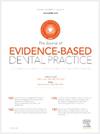口腔卫生专业人员对阻塞性睡眠呼吸暂停患者报告的结果进行评估
IF 4
4区 医学
Q1 DENTISTRY, ORAL SURGERY & MEDICINE
引用次数: 0
摘要
口腔卫生专业人员,包括普通牙医和正畸医生,可以在睡眠医学专家转诊时参与为患有阻塞性睡眠呼吸暂停(OSA)的成人和儿童提供护理。使用口腔矫治器(OA)已被提出作为成人轻度阻塞性睡眠呼吸暂停的一种可能的管理选择。在儿童中,虽然口服干预不被支持作为OSA的一线独立治疗选择,但短期研究表明,在较轻的病例中,口服干预可以改善睡眠体征和症状。监测OA干预措施的管理结果对于监测OSA状况至关重要。由于OSA的慢性性质,测量牙科患者报告的结果(dPROs)可能有助于了解影响OSA患者OA干预有效性的相互作用因素。这篇叙述性综述讨论了目前关于阻塞性睡眠呼吸暂停主要缺陷的证据、评估方法,以及口腔卫生专业人员在评估儿童和成人阻塞性睡眠呼吸暂停方面的贡献。OA使用者评估的主要dPROs包括生活质量、治疗依从性和副作用。在可用的情况下,必须优先使用经过验证的工具来测量dPROs。总之,口腔健康专业人员对dPROs的临床评估可能有利于监测OSA管理结果,必须鼓励作为睡眠医生领导的跨学科方法的一部分。本文章由计算机程序翻译,如有差异,请以英文原文为准。
ASSESSMENT BY ORAL HEALTH PROFESSIONALS OF PATIENT-REPORTED OUTCOMES IN OBSTRUCTIVE SLEEP APNEA
Oral health professionals, including general dentists and orthodontists, may participate in the provision of care to adults and children with obstructive sleep apnea (OSA) when referred by a sleep medicine specialist. The use of oral appliances (OA) has been presented as a possible management option for mild obstructive sleep apnea among adults. In children, although oral interventions are not supported as a first-line stand-alone management option for OSA, short-term studies have suggested an improvement in sleep signs and symptoms in milder cases. The monitoring of management outcomes from OA interventions is essential to monitor OSA conditions. Due to the chronic nature of OSA, the measure of dental patient-reported outcomes (dPROs) will likely help to understand interplaying factors that may influence the effectiveness of OA interventions among subjects with OSA. This narrative review discusses the current evidence regarding main dPROs in OSA, evaluation methods, and the contribution of oral health professionals in assessing it for both children and adults. The main dPROs assessed among OA users include quality of life, treatment adherence, and side effects. The use of validated tools to measure dPROs must be preferred when available. Overall, the clinical assessment of dPROs by oral health professionals is likely beneficial to monitoring OSA management outcomes and must be encouraged as part of an interdisciplinary approach led by the sleep physician.
求助全文
通过发布文献求助,成功后即可免费获取论文全文。
去求助
来源期刊

Journal of Evidence-Based Dental Practice
DENTISTRY, ORAL SURGERY & MEDICINE-
CiteScore
6.00
自引率
16.70%
发文量
105
审稿时长
28 days
期刊介绍:
The Journal of Evidence-Based Dental Practice presents timely original articles, as well as reviews of articles on the results and outcomes of clinical procedures and treatment. The Journal advocates the use or rejection of a procedure based on solid, clinical evidence found in literature. The Journal''s dynamic operating principles are explicitness in process and objectives, publication of the highest-quality reviews and original articles, and an emphasis on objectivity.
 求助内容:
求助内容: 应助结果提醒方式:
应助结果提醒方式:


